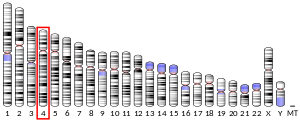SYNPO2
Myopodin protein, also called Synaptopodin-2 is a protein that in humans is encoded by the SYNPO2 gene.[5][6][7] Myopodin is expressed in cardiac, smooth muscle and skeletal muscle, and localizes to Z-disc structures.
Structure
Myopodin is a 117.4 kDa protein composed of 1093 amino acids,[8] although four alternatively-spliced isoforms have been described.[9] Myopodin contains one PPXY motif, multiple PXXP motifs, and two potential nuclear localization sequences (one N-terminal and one C-terminal).[5] PPXY motifs have been shown to mediate interactions, and PXXP motifs represent potential sites of interaction for SH3 domain-containing proteins. Myopodin contains a novel actin binding site (between amino acids 410 and 563) in the center of the protein.[5]
Function
During myotube differentiation, myopodin interacts with stress fibers prior to co-localizing with alpha actinin-2 at Z-discs in mature striated muscle cells.[5] Myopodin has been shown to shuttle between the nucleus and cytoplasm in myoblasts and myotubes in response to stress; its export from the nucleus is sensitive to lemtomycin B.[5] The nuclear localization of myopodin is sensitive to Importin 13, which directly binds myopodin and facilitates its translocation.[10] Importin binding and nuclear import of myopodin appears to be mediated by serine/threonine phosphorylation-dependent binding of myopodin to 14-3-3 beta [11] Myopodin appears to regulate compartmentalized, intracellular signal transduction between the Z-disc and nucleus in cardiac muscle cells, by forming a Z-disc signaling complex with alpha actinin-2, calcineurin, CaMKII, muscle-specific A-kinase anchoring protein, and myomegalin.[12] Specifically, phosphorylation by protein kinase A or CaMKII, and dephosphorylation by calcineurin facilitates the binding or release, respectively, of 14-3-3-beta, and the corresponding nuclear or cytoplasmic localization, respectively, of myopodin.[12]
Interactions
Myopodin interacts with:
References
- GRCh38: Ensembl release 89: ENSG00000172403 - Ensembl, May 2017
- GRCm38: Ensembl release 89: ENSMUSG00000050315 - Ensembl, May 2017
- "Human PubMed Reference:". National Center for Biotechnology Information, U.S. National Library of Medicine.
- "Mouse PubMed Reference:". National Center for Biotechnology Information, U.S. National Library of Medicine.
- Weins A, Schwarz K, Faul C, Barisoni L, Linke WA, Mundel P (Oct 2001). "Differentiation- and stress-dependent nuclear cytoplasmic redistribution of myopodin, a novel actin-bundling protein". The Journal of Cell Biology. 155 (3): 393–404. doi:10.1083/jcb.200012039. PMC 2150840. PMID 11673475.
- Liang J, Ke G, You W, Peng Z, Lan J, Kalesse M, Tartakoff AM, Kaplan F, Tao T (Jan 2008). "Interaction between importin 13 and myopodin suggests a nuclear import pathway for myopodin". Molecular and Cellular Biochemistry. 307 (1–2): 93–100. doi:10.1007/s11010-007-9588-1. PMID 17828378.
- "Entrez Gene: SYNPO2 synaptopodin 2".
- Joon-Sub Chung. "Cardiac Organellar Protein Atlas Knowledgebase (COPaKB) —— Protein Information". heartproteome.org.
- "SYNPO2 - Synaptopodin-2 - Homo sapiens (Human) - SYNPO2 gene & protein". uniprot.org.
- Liang J, Ke G, You W, Peng Z, Lan J, Kalesse M, Tartakoff AM, Kaplan F, Tao T (Jan 2008). "Interaction between importin 13 and myopodin suggests a nuclear import pathway for myopodin". Molecular and Cellular Biochemistry. 307 (1–2): 93–100. doi:10.1007/s11010-007-9588-1. PMID 17828378.
- Faul C, Hüttelmaier S, Oh J, Hachet V, Singer RH, Mundel P (May 2005). "Promotion of importin alpha-mediated nuclear import by the phosphorylation-dependent binding of cargo protein to 14-3-3". The Journal of Cell Biology. 169 (3): 415–24. doi:10.1083/jcb.200411169. PMC 2171942. PMID 15883195.
- Faul C, Dhume A, Schecter AD, Mundel P (Dec 2007). "Protein kinase A, Ca2+/calmodulin-dependent kinase II, and calcineurin regulate the intracellular trafficking of myopodin between the Z-disc and the nucleus of cardiac myocytes". Molecular and Cellular Biology. 27 (23): 8215–27. doi:10.1128/MCB.00950-07. PMC 2169179. PMID 17923693.
Further reading
- Houlgatte R, Mariage-Samson R, Duprat S, Tessier A, Bentolila S, Lamy B, Auffray C (Oct 1995). "The Genexpress Index: a resource for gene discovery and the genic map of the human genome". Genome Research. 5 (3): 272–304. doi:10.1101/gr.5.3.272. PMID 8593614.
- Hartley JL, Temple GF, Brasch MA (Nov 2000). "DNA cloning using in vitro site-specific recombination". Genome Research. 10 (11): 1788–95. doi:10.1101/gr.143000. PMC 310948. PMID 11076863.
- Wiemann S, Weil B, Wellenreuther R, Gassenhuber J, Glassl S, Ansorge W, Böcher M, Blöcker H, Bauersachs S, Blum H, Lauber J, Düsterhöft A, Beyer A, Köhrer K, Strack N, Mewes HW, Ottenwälder B, Obermaier B, Tampe J, Heubner D, Wambutt R, Korn B, Klein M, Poustka A (Mar 2001). "Toward a catalog of human genes and proteins: sequencing and analysis of 500 novel complete protein coding human cDNAs". Genome Research. 11 (3): 422–35. doi:10.1101/gr.GR1547R. PMC 311072. PMID 11230166.
- Simpson JC, Wellenreuther R, Poustka A, Pepperkok R, Wiemann S (Sep 2000). "Systematic subcellular localization of novel proteins identified by large-scale cDNA sequencing". EMBO Reports. 1 (3): 287–92. doi:10.1093/embo-reports/kvd058. PMC 1083732. PMID 11256614.
- Van Impe K, De Corte V, Eichinger L, Bruyneel E, Mareel M, Vandekerckhove J, Gettemans J (May 2003). "The Nucleo-cytoplasmic actin-binding protein CapG lacks a nuclear export sequence present in structurally related proteins". The Journal of Biological Chemistry. 278 (20): 17945–52. doi:10.1074/jbc.M209946200. PMID 12637565.
- Sanchez-Carbayo M, Schwarz K, Charytonowicz E, Cordon-Cardo C, Mundel P (Aug 2003). "Tumor suppressor role for myopodin in bladder cancer: loss of nuclear expression of myopodin is cell-cycle dependent and predicts clinical outcome". Oncogene. 22 (34): 5298–305. doi:10.1038/sj.onc.1206616. PMID 12917631.
- Jing L, Liu L, Yu YP, Dhir R, Acquafondada M, Landsittel D, Cieply K, Wells A, Luo JH (May 2004). "Expression of myopodin induces suppression of tumor growth and metastasis". The American Journal of Pathology. 164 (5): 1799–806. doi:10.1016/S0002-9440(10)63738-8. PMC 1615646. PMID 15111326.
- Wiemann S, Arlt D, Huber W, Wellenreuther R, Schleeger S, Mehrle A, Bechtel S, Sauermann M, Korf U, Pepperkok R, Sültmann H, Poustka A (Oct 2004). "From ORFeome to biology: a functional genomics pipeline". Genome Research. 14 (10B): 2136–44. doi:10.1101/gr.2576704. PMC 528930. PMID 15489336.
- Mehrle A, Rosenfelder H, Schupp I, del Val C, Arlt D, Hahne F, Bechtel S, Simpson J, Hofmann O, Hide W, Glatting KH, Huber W, Pepperkok R, Poustka A, Wiemann S (Jan 2006). "The LIFEdb database in 2006". Nucleic Acids Research. 34 (Database issue): D415–8. doi:10.1093/nar/gkj139. PMC 1347501. PMID 16381901.



